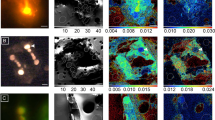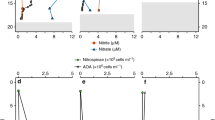Abstract
The availability of nitrogen is important in regulating biological productivity in marine environments. Deepwater nitrate has long been considered the major source of new nitrogen supporting primary production in oligotrophic regions of the open ocean, but recent studies have showed that biological N2 fixation has a critical role in supporting oceanic new production1,2,3,4,5,6,7. Large colonial cyanobacteria in the genus Trichodesmium and the heterocystous endosymbiont Richelia have traditionally been considered the dominant marine N2 fixers, but unicellular diazotrophic cyanobacteria and bacterioplankton have recently been found in the picoplankton and nanoplankton community of the North Pacific central gyre, and a variety of molecular and isotopic evidence suggests that these unicells could make a major contribution to the oceanic N budget8. Here we report rates of N2 fixation by these small, previously overlooked diazotrophs that, although spatially variable, can equal or exceed the rate of N2 fixation reported for larger, more obvious organisms. Direct measurements of 15N2 fixation by small diazotrophs in various parts of the Pacific Ocean, including the waters off Hawaii where the unicellular diazotrophs were first characterized, show that N2 fixation by unicellular diazotrophs can support a significant fraction of total new production in oligotrophic waters.
This is a preview of subscription content, access via your institution
Access options
Subscribe to this journal
Receive 51 print issues and online access
$199.00 per year
only $3.90 per issue
Buy this article
- Purchase on Springer Link
- Instant access to full article PDF
Prices may be subject to local taxes which are calculated during checkout



Similar content being viewed by others
References
Carpenter, E. J. & Romans, K. Major role of the cyanobacterium Trichodesmium in nutrient cycling in the North Atlantic Ocean. Science 254, 1356–1358 (1991)
Gruber, N. & Sarmiento, J. L. Global patterns of marine nitrogen fixation and denitrification. Glob. Biogeochem. Cycles 11, 235–266 (1997)
Lipschultz, F. & Owens, N. J. P. An assessment of nitrogen fixation as a source of nitrogen to the North Atlantic Ocean. Biogeochemistry 35, 261–274 (1996)
Michaels, A. F. et al. Inputs, losses and transformations of nitrogen and phosphorus in the pelagic North Atlantic Ocean. Biogeochemistry 35, 181–226 (1996)
Karl, D. et al. The role of nitrogen fixation in biogeochemical cycling in the subtropical North Pacific Ocean. Nature 388, 533–538 (1997)
Capone, D. G., Zehr, J. P., Paerl, H. W., Bergman, B. & Carpenter, E. J. Trichodesmium, a globally significant marine cyanobacterium. Science 276, 1221–1229 (1997)
Montoya, J. P., Carpenter, E. J. & Capone, D. G. Nitrogen-fixation and nitrogen isotope abundances in zooplankton of the oligotrophic North Atlantic. Limnol. Oceanogr. 47, 1617–1628 (2002)
Zehr, J. P. et al. Unicellular cyanobacteria fix N2 in the subtropical North Pacific Ocean. Nature 412, 635–638 (2001)
Montoya, J. P., Voss, M., Kaehler, P. & Capone, D. G. A simple, high precision, high sensitivity tracer assay for dinitrogen fixation. Appl. Environ. Microbiol. 62, 986–993 (1996)
Dore, J. E., Brum, J. R., Tupas, L. & Karl, D. M. Seasonal and interannual variability in sources of nitrogen supporting export in the oligotrophic subtropical North Pacific Ocean. Limnol. Oceanogr. 47, 1595–1607 (2002)
Falcon, L. I., Carpenter, E. J., Cipriano, F., Bergman, B. & Capone, D. G. N2 fixation by unicellular bacterioplankton from the Atlantic and Pacific Oceans: Phylogeny and in situ rates. Appl. Environ. Microbiol. 70, 765–770 (2004)
Capone, D. G., O'Neil, J. M., Zehr, J. & Carpenter, E. J. Basis for diel variation in nitrogenase activity in the marine planktonic cyanobacterium Trichodesmium thiebautii. Appl. Environ. Microbiol. 56, 3532–3536 (1990)
Chen, Y.-B., Zehr, J. P. & Mellon, M. T. Growth and nitrogen fixation of the diazotrophic filamentous nonheterocystous cyanobacterium Trichodesmium sp. IMS101 in defined media: evidence for a circadian rhythm. J. Phycol. 32, 916–923 (1996)
Lee, K., Karl, D. M., Wanninkhof, R. H. & Zhang, J. Z. Global estimates of net carbon production in the nitrate-depleted tropical and subtropical oceans. Geophys. Res. Lett. 29 (2002) doi: 10.1029/2001GLO14198
Allen, C. B., Kanda, J. & Laws, E. A. New production and photosynthetic rates within and outside a cyclonic mesoscale eddy in the North Pacific subtropical gyre. Deep-Sea Res. I 43, 917–936 (1996)
Aufdenkampe, A. K. et al. Biogeochemical controls on new production in the tropical Pacific. Deep-Sea Res. II 49, 2619–2648 (2002)
Carpenter, E. J., Subramaniam, A. & Capone, D. G. Biomass and productivity of the cyanobacterium, Trichodesmium spp. in the tropical North Atlantic Ocean. Deep-Sea Res. I 51, 173–203 (2004)
Tillett, D. & Neilan, B. A. Xanthogenate nucleic acid isolation from cultured and environmental cyanobacteria. J. Phycol. 36, 251–258 (2004)
Zehr, J. P. & Turner, P. J. in Methods in Marine Microbiology (ed. Paul, J. H.) 271–286 (Academic, San Diego, 2001)
Zehr, J. P. & McReynolds, L. A. Use of degenerate oligonucleotides for amplification of the nifH gene from the marine cyanobacterium Trichodesmium thiebautii. Appl. Environ. Microbiol. 55, 2522–2526 (1989)
Wessel, P. & Smith, W. H. F. New, improved version of Generic Mapping Tools released. Eos 79, 579 (1998)
Goering, J. J., Dugdale, R. C. & Menzel, D. W. Estimate of in situ rates of nitrogen uptake by Trichodesmium sp. in the Tropical Atlantic Ocean. Limnol. Oceanogr. 11, 614–620 (1966)
Carpenter, E. J. & Price, C. C. Nitrogen fixation, distribution and production of Oscillatoria (Trichodesmium) spp. in the western Sargasso and Caribbean Seas. Limnol. Oceanogr. 22, 60–72 (1977)
Orcutt, K. M. et al. A seasonal study of the significance of N2 fixation by Trichodesmium spp. at the Bermuda Atlantic Time-series Study (BATS) site. Deep-Sea Res. II 48, 1583–1608 (2001)
Gundersen, K. R. et al. Structure and biological dynamics of the oligotrophic ocean photic zone off the Hawaiian Islands. Pacif. Sci. 30, 45–68 (1976)
Saino, T. Biological Nitrogen Fixation in the Ocean with Emphasis on the Nitrogen Fixing Blue-Green Alga, Trichodesmium, and its Significance in the Nitrogen Cycle in the Low Latitude Sea Areas (Univ. Tokyo, Tokyo, 1977)
Capone, D. G. et al. An extensive bloom of the N2-fixing cyanobacterium, Trichodesmium erythraeum, in the central Arabian Sea. Mar. Ecol. Prog. Ser. 172, 281–292 (1998)
Carpenter, E. J. et al. Extensive bloom of a N2-fixing diatom/cyanobacterial association in the tropical Atlantic Ocean. Mar. Ecol. Prog. Ser. 185, 273–283 (1999)
Deutsch, C. et al. Denitrification and N2 fixation in the Pacific Ocean. Glob. Biogeochem. Cycles 15, 483–506 (2001)
Acknowledgements
We thank D. Karl and the entire HOT team for support in Hawaii; A. Gibson for collecting samples for molecular characterization on cruise Cook-25; C. Payne, K. Rathbun, S. Patel, K. Ghanouni, P. Davoodi and G. Stewart for their assistance in the laboratory analyses; and the captains and crews of the RV Ewing and RV Melville for their assistance at sea. This research was supported by grants from the National Science Foundation.
Author information
Authors and Affiliations
Corresponding author
Ethics declarations
Competing interests
The authors declare that they have no competing financial interests.
Rights and permissions
About this article
Cite this article
Montoya, J., Holl, C., Zehr, J. et al. High rates of N2 fixation by unicellular diazotrophs in the oligotrophic Pacific Ocean. Nature 430, 1027–1031 (2004). https://doi.org/10.1038/nature02824
Received:
Accepted:
Issue Date:
DOI: https://doi.org/10.1038/nature02824
This article is cited by
-
The rate and fate of N2 and C fixation by marine diatom-diazotroph symbioses
The ISME Journal (2022)
-
Evidence of the Significant Contribution of Heterotrophic Diazotrophs to Nitrogen Fixation in the Eastern Indian Ocean During Pre-Southwest Monsoon Period
Ecosystems (2022)
-
The population of Trichodesmium cyanobacteria in the northern Pacific Ocean associated with Kuroshio Extension
Aquatic Sciences (2022)
-
The particle fluxes in sediment traps from Niulang Guyot area in the Northwest Pacific Ocean
Acta Oceanologica Sinica (2022)
-
Heterogeneous nitrogen fixation rates confer energetic advantage and expanded ecological niche of unicellular diazotroph populations
Communications Biology (2020)
Comments
By submitting a comment you agree to abide by our Terms and Community Guidelines. If you find something abusive or that does not comply with our terms or guidelines please flag it as inappropriate.



